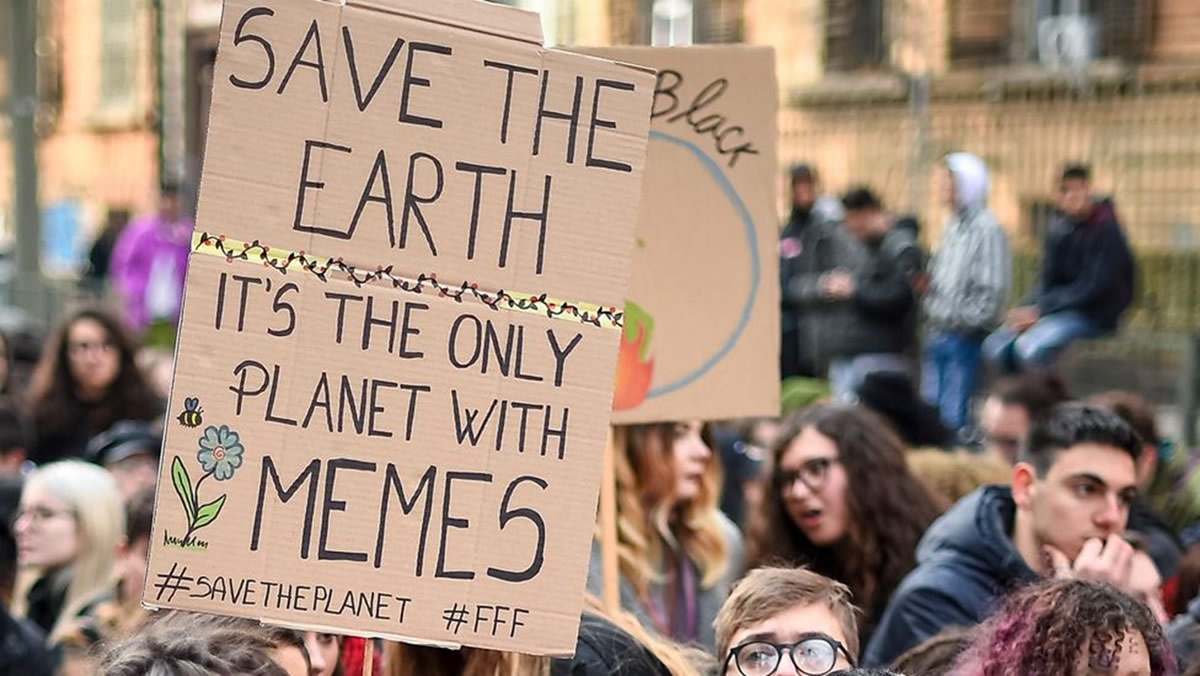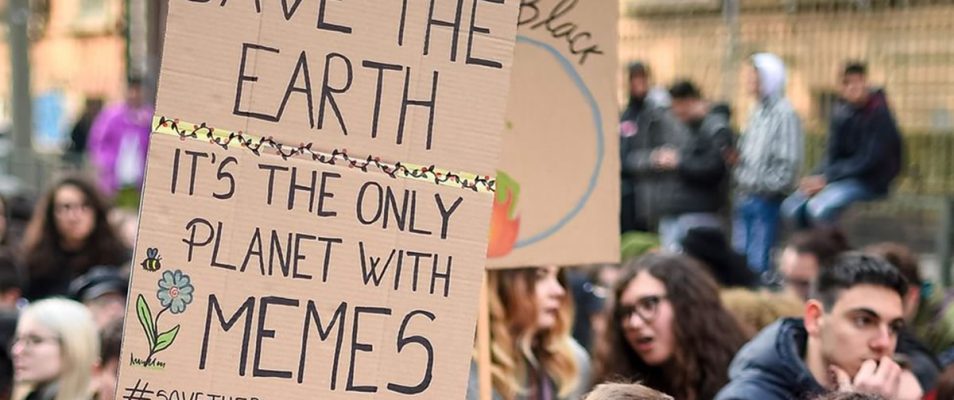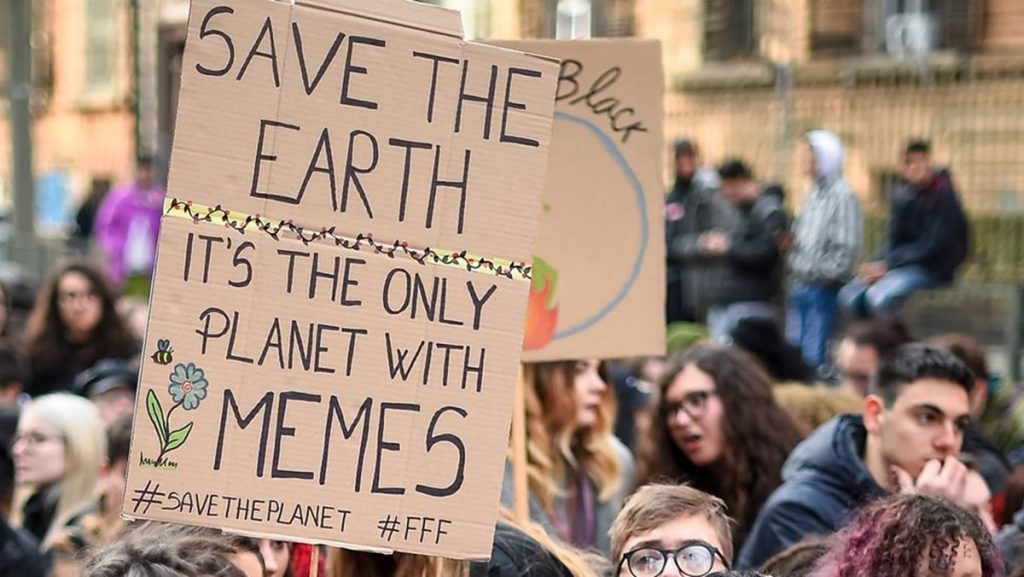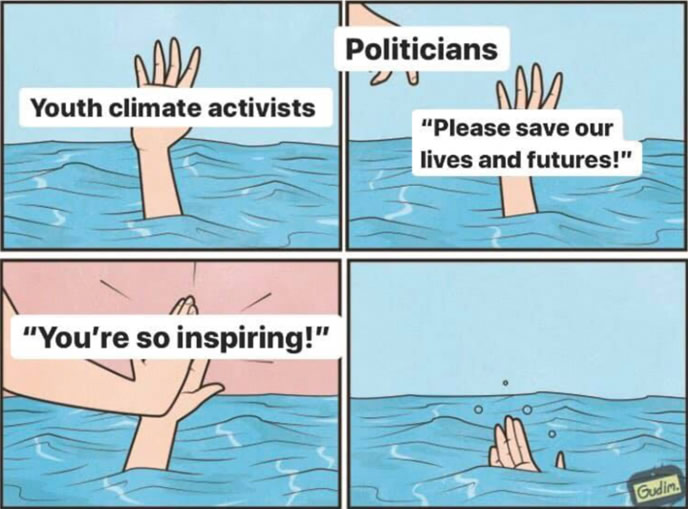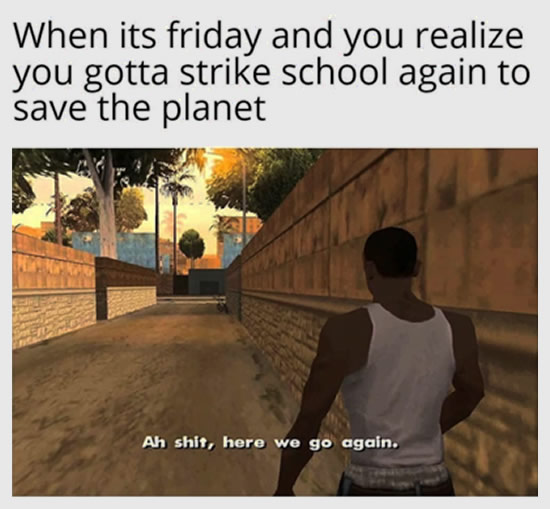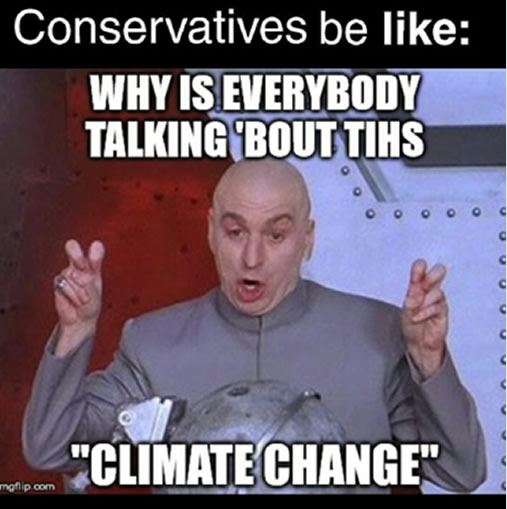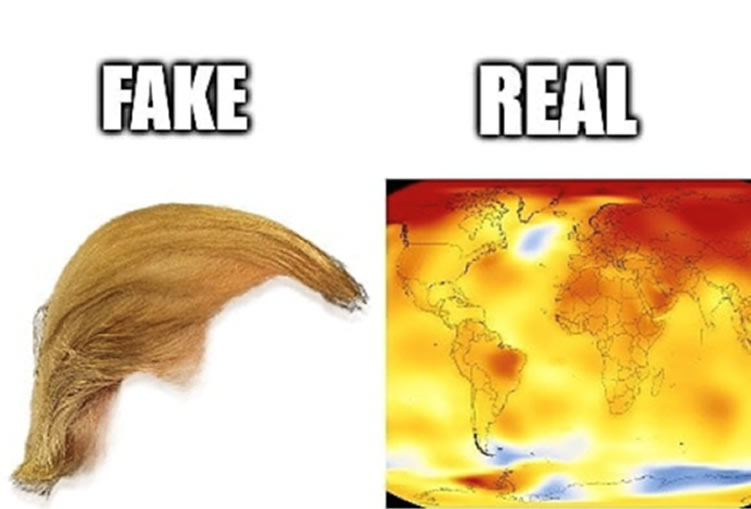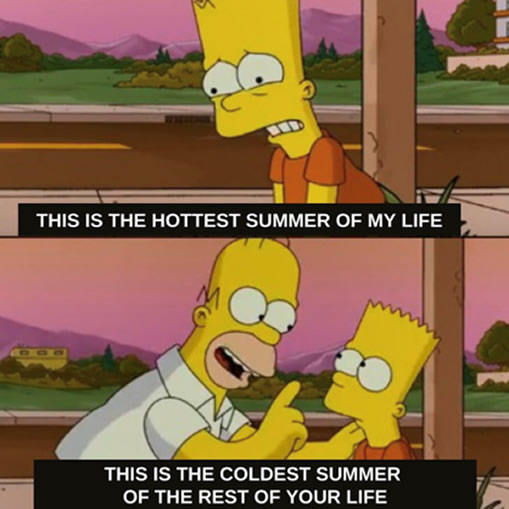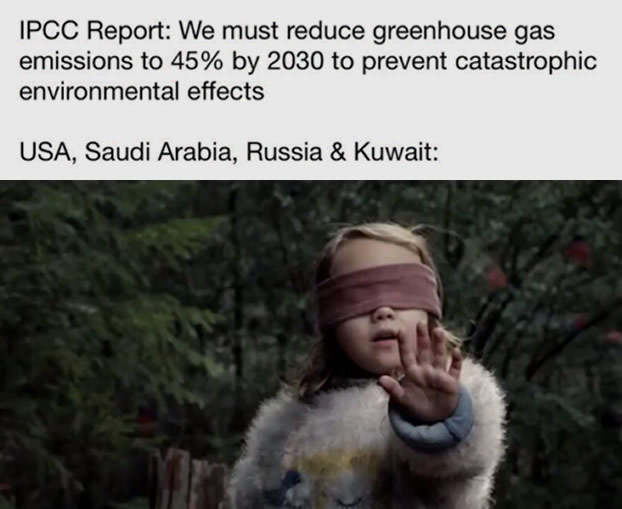Climate change memes as an effective activist communication tool
As highlighted in previous blog posts, climate activists use a wide variety of communication styles, methods, narratives, and rhetoric for convincing, engaging, mobilizing and for putting pressure on policy makers. In my first blog post, so called shaming how-dare-you rhetoric from different climate activist groups were analyzed and in our joint, interactive blog post, I highlighted digital climate protest songs. Even though, it could be argued that the digital aspect is fairly new and have added a new dimension to protest songs and public shaming, both of these communication styles are historically very characteristically for activist movements. In this post, focused will be directed towards a newer from of climate activist communication that in many ways can be regarded to stand in stark contrast to what usually have been an expected activist communication style. This blog post will examine and discuss how climate activist use memes as an effective communication tool to contribute to and steer the global conversation on climate change. The aim is to look at the factors making memes a successful new digital media for climate activists as well as if this simple communication style really does have the power to lead to social change.
What are memes and how do they relate to new digital technology?
Internet memes, or just memes, gained popularity in parallel with the raise of the Internet in the early 21st century and spread from person to person through e-mail, social media, or websites. Memes usually contains of pictures, videos or other media that has been deliberately altered by individuals to create communicative message (Rogers, 2023). Memes, which by Shipman (2013) are defined as “the propagation of content items such as jokes, rumors, videos, or websites from one person to others via the Internet” have thanks to the simplistic character that appears to pair especially well with the development of visual platforms such as Instagram become a popular new media used for different communicative purposes by different actors. Memes are, as mentioned, a used-generated content which could be created and used with the intention to for example spread political messages, satire, or to capture debates over notions of legitimacy (Ross & Rivers, 2019). Even though, memes are used for a variety of different communicative messages the humorous undertone appears to be the common attribute for the media. A wide spectrum of this humorous undertone can however be observed, going from witty, funny, amusing to ironic, sarcastic, and dark humor. Thanks to its humorous undertone, memes as a media allow for political messages to be a natural, embedded part of the daily entertainment scrolling on social media.
Why do memes appear to be an especially effective digital media for climate activists?
On one hand it could be said that memes as a newer communication style is a lot different from what historically have been expected from climate activists – handwritten placards, protest songs, symbols, and unified marches. On the other hand, one could argue if the leap from the traditional activist communication methods really is that big. Activist placards for example, often contains short, to the point message usually phrased in a catchy way. Just as the protest placards, memes can serve as a bond that ties people and culture together by providing instant recognition of a commonality in shared ideas, meanings, and practices (Francisco, 2014).
Allowing for instant recognition of corresponding values and standpoints appear to have become more and more important as we moved into what Tufekci (2017) describes as the digital networked public sphere. The digital networked public sphere is a term referring to the “complex interaction of publics, online and offline, all intertwined, multiple, connected, and complex, but also transnational and global” (Tufekci, 2017 p. 6). The term relates to a 21st century public sphere as whole, including offline and inline where both mass media, public spaces with squares, parks and protests are held as well as the broadcasting possibility for ordinary people with the possibilities to reach millions.
In a complex and often chaotic world of the digitally networked public sphere, where content compete for attention, and individualism is growing, there is at the same time a need for people to be able to spot and recognise their preferences. Before the internet and memes, street protest could help people show that they were not alone and giving an opportunity for discovering common grounds (Tufekci, 2017). In many ways, it could now be said that memes carry that same function. The street placards have now become digital placards in shape of memes and as street protest gives the bypasses the opportunity to show their support by joining in and holding up a placard of their own, the digital protests give the audience the opportunity to press like or reshare the content.
From a communication for development perspective, it is interesting to also consider which of these two forms of protests, offline or online, that gives greater opportunity for dialogue, participation, and conversation. As street protests used to be limited to a physical place, digital protests and memes have the possibility to go viral and reach a global audience. Of course, the divide between offline and online becomes more and more blurred out, something that Tufekci also points out, as street protest many times also are recorded and published on social media and sometimes also might be picked up and broadcasted by news outlets. The main challenge for digital protests is to gain attention as it competes and operates in a sea of other attention seeking content and many times only have split second to capture the audience interest before it has been “by scrolled” and already is miles away in feed of funny cat videos and other political or commercial messages.
Memes as attention makers
Let’s take a closer look at how memes could be an effective activist communication tool for breaking through that noise and stick out as an attention maker amongst all other content, because as Tufekci states ”attention is oxygen for movements, without it they cannot catch fire” (Tufekci, 2017 p. 30). As it gets harder for physical street protest to compete for digital attention, where the options appear either to record and publish in owned channels or hope that media outlets find the protest newsworthy enough to report on, memes can work as complementary attention maker in the digital sphere. As touched upon before, memes resemble the physical protest placards in several ways with its short, concrete messages which instantly communicates a standpoint. From an attention perspective, memes are compared to placards, more adapted to fit the context of social media, which by many is used as a tool for entertainment, relaxation, and creating or maintaining connections. If you are looking for entertainment, memes provide a reason to make a stop in the scrolling, to read the catchy headline and look the picture. It doesn’t even matter if you agree to the standpoint made in the meme or not. The attributes of memes, with a short text over a picture, makes the media instantly recognizable for many and by that also leaves a guarantee that the content will provide some humorous seconds. Attention is created.
Frames used in climate memes
But attention is not the whole picture and does not necessarily mean anything in itself if it doesn’t lead to some sort of action. The second step for activists working with memes is to engage the audience in the actual content and message. In this second step it becomes interesting to look at memes from a framing perspective. Framing theory has for long been used as a tool for analyzing the presentation and the interpretation of news information and media, where “the primary objective of a frame is to emphasize the salience of different aspects of a topic” (Ross & Rivers, 2019). Frames, as an interpretive tool can also support the audience categorize and process information and ultimately also contribute to decisions around meaning making (Ross & Rivers, 2019).
Analyzing different memes addressing the topic of climate change from a frame and salience perspective could support in understanding why this media is especially effectful for activists in creating engagement in both the activist movement and the topic of climate change. Let’s have closer look at a few examples and how frame and salience are applied on memes to create attention for different topics in the climate change debate and support climate activist reach different audiences.
In the first two meme examples below, the frame relates to people already convinced about the climate crisis and who most likely already are engaged in some sort of activist movements. In the meme to the left, a polarization between youth climate activists and politicians also is made salient. In the meme to the right, the frame relates to the Fridays For Future movement, who uses Fridays as their official protest days, and where the intention of the meme could be perceived as a way to strengthen a sense of belonging and understanding amongst the movement’s members/followers.
In the following two memes the frame has changed from targeting people who already are convinced about the climate crisis to addressing climate deniers. These two memes also contain the element of polarization which forces the audience into taking a standpoint, as you either relate to that climate change is real or have to identify as an ignorant conservative (meme to the left) or someone with fake hair, spreading fake news (hair-raising meme to the right).
Another common seen frame in climate change memes, illustrated with below two memes, focuses on emphasizing facts connected to climate change, its actual effects or capturing highlights from scientific reports. This sort of memes can have the ability to boil down an extremely complex topic into something that is easy to take in and by that providing an educational element packaged in humoristic way. This simple, humoristic approach to information and science could maybe work as complement to complex, serious, doomsday-like communication around climate change from other actors such as news outlets, scientists, and international development organizations. These memes could create the feeling that you get information from a friend and therefore they also have the possibility of converting and engaging people who previously not been active in the climate debate.
Conclusion
In this very last blog post from my side, I have taken a closer look at how climate activists work with the digital media Internet memes, how it relates to other activist communication activities and how it can be an effective tool for attention and engagement in the digital sphere. As illustrated, memes can work as a humorous vehicle for political expression and provide guidance for audiences to find belonging and establish a position to the topics of climate change.
The equation of visual social media platforms, such as Instagram paired with activist generated memes appear to be an especially effective tool for digital political engagement, but is this digital political engagement only related to passive slacktivism or can it actually be regarded as form of communication for social changemaking as described by Noske-Turner (2023). Noske-Turner (2023) presents an evolved concept of communication for development, called “communication for social changemaking”, which builds on the ideas of horizontal or bottom-up dialogue from the participatory paradigm by complementing it with ideas around leadership and mobilization. Looking at memes as single content type it might be a far stretch to say that it contributes to social changemaking, but when considering memes as a tool that has the possibility to, in Francisco’s (2014) words “replicates and transfers itself from one mind to another thereby constructing a reality based on semiotics or shared meaning” memes could be regard as form communication for social change that accommodate for common grounds and strengthen the willingness to become part of a social behaviour, movement or culture.
Critics could of course argue that climate memes provide a heavily simplified version of climate change, contribute to polarization, and exclude the true complexity of the topic, but maybe Marshall McLuhan’s theory about the medium being the message is applicable also for memes. As memes really is more about what they have the potential of accomplish in terms of political engagement, creating shared meanings and common ground, and by that also to mobilization and change.
Personal learning reflections
I am interested in climate change communication and how climate change communication from different actors effects our perception and how we think, feel, and act in relation to the climate crisis. Climate change communication includes information, messages, stories, scientifical reports, news, historical narratives, fiction, marketing, and fake news from actors belonging to all layers of society – politicians, journalist, activists, scientists, businesses, international development organizations, movements, local communities, and influencers. Many of us are exposed to this wide spectrum of climate change communication from numerous different actors on a daily basis and it shapes and form our perception on climate change. This blog project has allowed me to take a closer look at and examine climate communication coming from climate activists. This has been truly fascinating and insightful as this is a societal actor that in many ways steer the global conversation on climate change and pushes the dialogue to where it needs to be by using or sometime also shapes the communication methods that are relevant and effective for a new digital media.
When it comes to the experience of the process of blogging, I very much relate to Agnes’ reflection on the legitimacy of a blog as a medium, and also find myself connecting this to theory around rhetoric and ethos. Where ethos, that means character, refers to authors trustworthiness and how well it corresponds with the audience ethics. With a background in marketing I can’t help also drawing parallels to brand building as creating a new blog and channel in many ways is similar to creating a new brand or character. When the reader or audience determine whether the The Illegit Activism Blog is a trustworthy source or not, it is most likely more about the blog as whole rather than us authors as individuals. The blog as a medium becomes the main character that the reader chose to identify with or not. Doing this blog project as group exercise have highlighted the importance of balancing, on one hand, a strong theme and consistent approach throughout in order to build a trustworthy ethos and on the other hand harvesting the benefits of the individual interests and perspectives in the group, making the content more dynamic and with the possibility of also reaching a broader audience.
A big thank you to my fellow group members and co-authors, I have learnt a lot and truly enjoyed doing this journey together with you!
All the best,
Cecilia
References
Francisco, T. (2014). Effective Use of Memes In Development Communication. University of the Philippines Open University https://www.researchgate.net/publication/269333788_Effective_Use_of_Memes_In_Development_Communication
Noske-Turner, J. 2023. Communication for Social Changemaking: A “New Spirit” in Media and Communication for Development and Social Change? International Journal of Communication, 17(2023), 2944–2966.
Rogers, K. (2023, October 11). meme. Encyclopedia Britannica. https://www.britannica.com/topic/meme
Ross, A. & Rivers, D. (2019). Internet Memes, Media Frames, and the Conflicting Logics of Climate Change Discourse. Environmental Communication. https://www.tandfonline.com/doi/abs/10.1080/17524032.2018.1560347
Shifman, L. (2013). Memes in a Digital World: Reconciling with a Conceptual Troublemaker, Journal of Computer-Mediated Communication, Volume 18, Issue 3, 1 April 2013, Pages 362–377, https://doi.org/10.1111/jcc4.12013
Tufekci, Z. 2017: Twitter and Tear Gas-The Power and Fragility of Networked Protest

